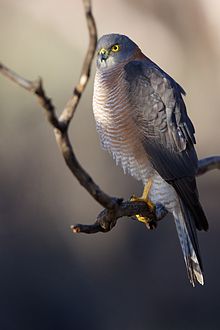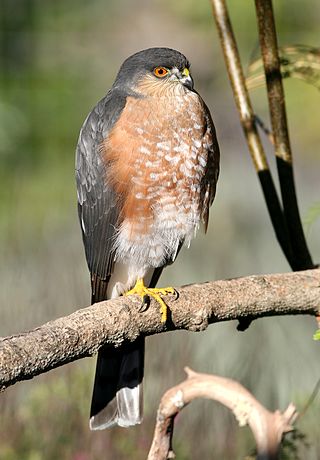
The sharp-shinned hawk or Northern sharp-shinned hawk, commonly known as a sharpie, is a small hawk, with males being the smallest hawks in the United States and Canada, but with the species averaging larger than some Neotropical species, such as the tiny hawk. The taxonomy is far from resolved, with some authorities considering the southern taxa to represent three separate species: white-breasted hawk, plain-breasted hawk, and rufous-thighed hawk. The American Ornithological Society keeps all four variations conspecific.

The Accipitrinae are the subfamily of the Accipitridae often known as the "true" hawks, including all members of Accipiter and the closely related genera Microspizias, Erythrotriorchis, and Megatriorchis. The large and widespread genus Accipiter includes goshawks, sparrowhawks, the sharp-shinned hawk and others. They are primarily woodland birds that hunt by sudden dashes from a concealed perch, with long tails, broad wings and high visual acuity facilitating this lifestyle. In light of recent genetic research, the kites of the traditional subfamily Milvinae may also belong to this group.

The besra, also called the besra sparrowhawk, is a bird of prey in the family Accipitridae.

The red goshawk is probably the rarest Australian bird of prey. It is found mainly in the savanna woodlands of northern Australia, particularly near watercourses. It takes a broad range of live prey, mostly birds.

The Levant sparrowhawk is a small bird of prey. It measures 32–38 cm (13–15 in) in length with a wingspan of 65–75 cm (26–30 in). The female is larger than the male, but the difference is not as marked as with Eurasian sparrowhawk. The adult male is blue-grey above, with dark wingtips, and barred reddish below.

The square-tailed kite is a medium-sized bird of prey in the family Accipitridae, which also includes many other diurnal raptors such as kites, eagles and harriers.

The Australian hobby, also known as the little falcon, is one of six Australian members of the family Falconidae. This predominantly diurnal bird of prey derives its name ‘longipennis’ from its long primary wing feathers. It occurs throughout Australia and other neighbouring countries with migrating individuals found on the islands of Indonesia and New Guinea.

Frances's sparrowhawk is a small bird of prey. The nominate subspecies, A. f. francesiae, is endemic to Madagascar, and the other subspecies are found in the Comoro Islands.

The Japanese sparrowhawk is a bird of prey in the family Accipitridae which also includes many other diurnal raptors such as eagles, buzzards and harriers. The bird is known by many alternative names such as the Japanese lesser, Asiatic, or Eastern sparrowhawk. The sparrowhawk is a small raptor with broader and rounder wings and a shorter tail. It has a dark back and whitish underside with brown-grey barring and red-brown colouring on the sides in males, and with heavier brown barring on the abdomen in females. Both sexes have a stripe across the throat, but its more obvious in the female. There are three subspecies of Japanese sparrowhawk. The species is globally listed as least concern, although it is listed as endangered in Japan and protected in China.

The brown goshawk is a medium-sized bird of prey in the family Accipitridae found in Australia and surrounding islands.

The tiny hawk is a small diurnal bird of prey found in or near forests, primarily humid, throughout much of the Neotropics. It is primarily a bird-eater, and is known to prey on hummingbirds.

The chestnut-flanked sparrowhawk is a small west African species of sparrowhawk in the family Accipitridae.

The red-thighed sparrowhawk, alternatively known as the red-legged sparrowhawk or western little sparrowhawk, is a species of sparrowhawk in the family Accipitridae from western and northern central Africa.

The little sparrowhawk is a species of Afrotropical bird of prey in the family Accipitridae. It is the smallest member of the genus Accipiter and forms a superspecies with the red-thighed sparrowhawk.
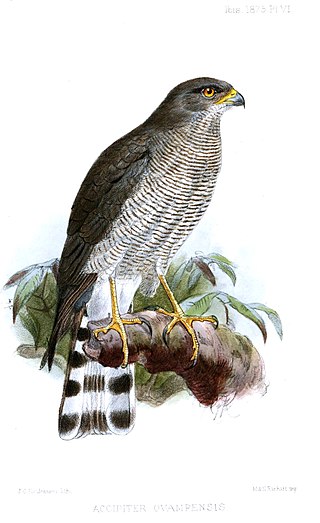
The Ovambo or Ovampo sparrowhawk, also known as Hilgert's sparrowhawk, is a species of sub-Saharan African bird of prey in the family Accipitridae. It takes its name from the Ovamboland in northern Namibia.

The rufous-breasted sparrowhawk, also known as the rufous-chested sparrowhawk and as the red-breasted sparrowhawk, is a species of bird of prey in the family Accipitridae. It is found in Angola, Democratic Republic of the Congo, Eritrea, Eswatini, Ethiopia, Kenya, Lesotho, Malawi, Mozambique, Rwanda, South Africa, South Sudan, Tanzania, Uganda, Zambia, and Zimbabwe.

The African goshawk is an African species of bird of prey in the genus Accipiter which is the type genus of the family Accipitridae.

The black-collared hawk is a species of bird of prey in the family Accipitridae. It is monotypic within the genus Busarellus. It has a widespread range of presence, from western Mexico to Uruguay. Its natural habitats are subtropical or tropical moist lowland forests, subtropical or tropical swamps, and swamps.
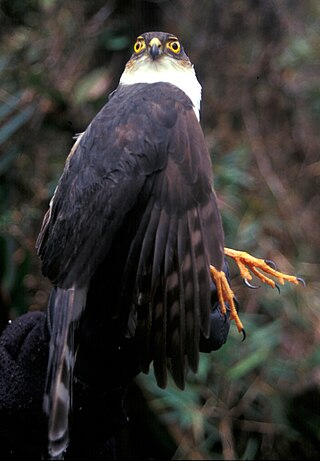
The plain-breasted hawk is a small hawk described from Venezuela to western Bolivia. It is usually considered a subspecies of the sharp-shinned hawk by most taxonomists, including the American Ornithological Society, but the taxonomy is far from resolved, with some authorities considering the southern taxa to represent three separate species: white-breasted hawk, plain-breasted hawk, and rufous-thighed hawk.
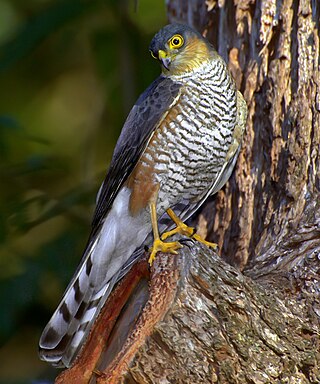
The rufous-thighed hawk is a small hawk found from southern Brazil and southeastern Bolivia to Paraguay, Uruguay and northern Argentina. It is usually considered a subspecies of the sharp-shinned hawk by most taxonomists, including the American Ornithological Society, but the taxonomy is far from resolved, with some authorities considering the southern taxa to represent three separate species: white-breasted hawk, plain-breasted hawk, and rufous-thighed hawk.
